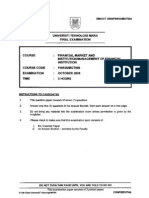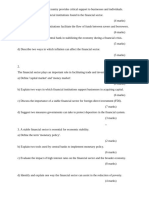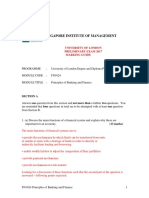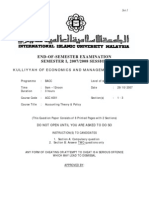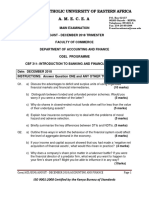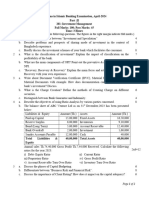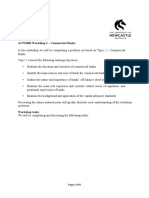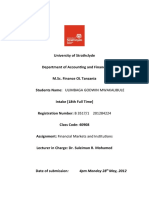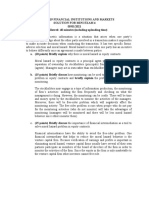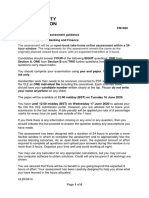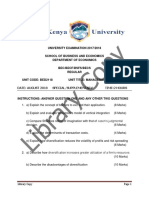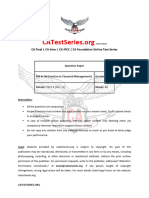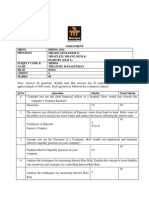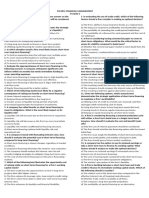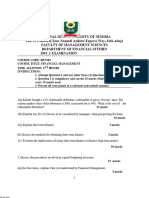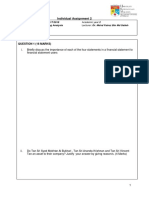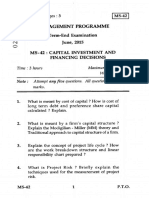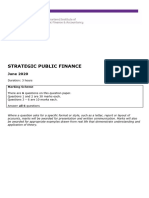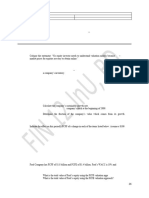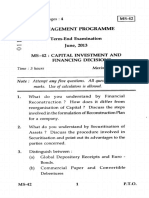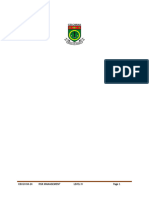Bac 310 Management of Financial Institutions
Bac 310 Management of Financial Institutions
Uploaded by
Steve JonesCopyright:
Available Formats
Bac 310 Management of Financial Institutions
Bac 310 Management of Financial Institutions
Uploaded by
Steve JonesOriginal Description:
Original Title
Copyright
Available Formats
Share this document
Did you find this document useful?
Is this content inappropriate?
Copyright:
Available Formats
Bac 310 Management of Financial Institutions
Bac 310 Management of Financial Institutions
Uploaded by
Steve JonesCopyright:
Available Formats
MACHAKOS UNIVERSITY COLLEGE
(A Constituent College of Kenyatta University)
University Examinations for 2015/2016 Academic Year
SCHOOL OF BUSINESS AND ECONOMICS
DEPARTMENT OF BUSINESS ENTREPRENEURSHIP AND MANAGEMENT
SCIENCES
SECOND SEMESTER EXAMINATION FOR DEGREE IN BACHELOR OF
COMMERCE
BAC 310: MANAGEMENT OF FINANCIAL INSTITUTIONS
Date: 27/4/2016 Time: 8:30 – 10:30 AM
INSTRUCTIONS
Answer Question One and Any Other Two Questions
1. a) compare and contrast pension benefits from provident fund benefits. (6 marks)
b) Until recently, the common belief was that financial institutions existed to solve
other institutions financial management problems. With examples, explain the
main issues that managers of today’s financial institutions need to address to
ensure solvency and profitability of those institutions. (6 marks)
c) Explain the main regulations of insurance companies. (5 marks)
d) Explain the three main investment advisory companies (2 marks)
e) How can a financial institution be subject to sovereign risk even if it lends to the
highest quality foreign corporations. (3 marks)
f) How do financial institutions use securitization to manage their interest rate
,credit and liquidity risk. (4 marks)
2. a) By law the activities of most financial institutions were limited so that for several
decades their financial management was not a terribly complex process.
regulators set prices and costs such that financial institutions were usually
profitable and relatively few failed. Explain the challenges that face the present
day financial institutions especially those operating in a financially liberalized
environment. (10 marks)
Examination Irregularity is punishable by expulsion Page 1 of 2
b) State and briefly explain six aspects of internal controls that deserve special
attention in management of financial institutions (6 marks)
c) Identify any incidences in the recent past that the central bank of Kenya has
applied moral suasion in the context of monetary regulation. (4 marks)
3. a) Explain the main objectives of regulating financial institutions in Kenya.
(6 marks)
b) Explain the following benefits of financial intermediation. (2 mks each)
i) transmission of monetary policy
ii) reduced transaction cost
iii) maturity intermediation
c) In what ways does credit analysis of a mid market borrower differ from that of a
small business borrower. (4 marks)
d) How does securitization help a financial institution manage its interest rate risk
and liquidity risk exposure. (4 marks)
4. a) when a steel company goes bankrupt ,other companies in the same industry
benefit because they have one less competitor. but when a bank goes bankrupt
other banks do not necessarily benefit. Explain this statement. (6 marks)
b) If a financial institution funds longterm assets with short term liabilities, what will
be the impact of an interest rate increase on earnings? (5 marks)
c) how does the regulation of insurance companies compare with that of
commercial banks. (3 marks)
d) Explain the main functions of the front office part of an investment bank.
(6 marks)
5. a) state and explain five functions of insurance regulatory authority [IRA] (5 marks)
b) the retirement benefits authority[RBA] has indicated a shift to a risk based
approach to supervision under which it will direct resources and regulatory focus
to the areas that pose the greatest risk to achieving statutory objectives. Discuss
this statement. (5 marks)
c) Discuss how economic transactions between household savers of funds and
corporate users of funds would occur in a world without financial intermediaries.
(10 marks)
Examination Irregularity is punishable by expulsion Page 2 of 2
You might also like
- 96th AIBB RMFI Solved-2-1Document20 pages96th AIBB RMFI Solved-2-1Shamima Akter100% (1)
- BSF 3202 - Financial Institutions and Markets - November 2019Document4 pagesBSF 3202 - Financial Institutions and Markets - November 2019Ian MunyingiNo ratings yet
- Universiti Teknologi Mara Final Examination: Confidential BM/APR 2008/FIN536Document5 pagesUniversiti Teknologi Mara Final Examination: Confidential BM/APR 2008/FIN536azwan ayopNo ratings yet
- Oct 2008Document3 pagesOct 2008azwan ayopNo ratings yet
- Oct 2007Document4 pagesOct 2007azwan ayopNo ratings yet
- BAF 313 EXAMDocument5 pagesBAF 313 EXAMkennedymustafa11No ratings yet
- Exam Structured Questsions - EconomicsDocument5 pagesExam Structured Questsions - Economicshellfireclub.strangerthings.jjNo ratings yet
- 2017 PBF MockDocument12 pages2017 PBF MockBryan SingNo ratings yet
- Accounting Theory and Policy - (Final Paper) - International Islamic University MalaysiaDocument6 pagesAccounting Theory and Policy - (Final Paper) - International Islamic University MalaysiaMaas Riyaz Malik100% (1)
- CBF 311 OdelDocument2 pagesCBF 311 OdelRay RoseNo ratings yet
- Pyq Maf663 Feb 21Document4 pagesPyq Maf663 Feb 212021117961No ratings yet
- TMFI 98th SolvedDocument23 pagesTMFI 98th SolvedInternal Control Department Woori BankNo ratings yet
- Part-II May 2024 FinalDocument11 pagesPart-II May 2024 Finalecomm14No ratings yet
- ACFI1003 Workshop 2 QuestionsDocument6 pagesACFI1003 Workshop 2 Questions王亚琪No ratings yet
- Screenshot 2023-05-04 at 11.40.13 PDFDocument5 pagesScreenshot 2023-05-04 at 11.40.13 PDFTshidiso KgosiemangNo ratings yet
- Fin501: Financial Management MBA BRAC University Final Examination Paper: 3rd of January 2021 Total Time: Three (3) Hours Total: 60 MarksDocument16 pagesFin501: Financial Management MBA BRAC University Final Examination Paper: 3rd of January 2021 Total Time: Three (3) Hours Total: 60 MarksyousufNo ratings yet
- Mba DEC 2022 Exam - MergedDocument13 pagesMba DEC 2022 Exam - MergedAman SharmaNo ratings yet
- MA922 2016 PaperDocument6 pagesMA922 2016 Paperrenaldo1976No ratings yet
- 96th AIBB TMFI SolvedDocument26 pages96th AIBB TMFI SolvedShamima AkterNo ratings yet
- Apr-May 2012Document6 pagesApr-May 2012Charity FrostNo ratings yet
- CFIFS (2nd) May2019Document2 pagesCFIFS (2nd) May2019Jagjit GillNo ratings yet
- Advanced AuditingDocument5 pagesAdvanced Auditingy mugambiNo ratings yet
- MSC Finance Full Time Financial Markets and Institutions Assignment ReportDocument4 pagesMSC Finance Full Time Financial Markets and Institutions Assignment ReportLumumba KuyelaNo ratings yet
- DP 01Document15 pagesDP 01Mohammad FahmiNo ratings yet
- IFS End Term 2015Document6 pagesIFS End Term 2015SharmaNo ratings yet
- Solution For Mini Exam 4Document3 pagesSolution For Mini Exam 4EdNo ratings yet
- B7AF100 - 2021 - OMD1 - First Sitting Exam PaperDocument12 pagesB7AF100 - 2021 - OMD1 - First Sitting Exam PaperAZLEA BINTI SYED HUSSIN (BG)No ratings yet
- Financial Management - Paper 10Document10 pagesFinancial Management - Paper 10Jacob Baraka OngengNo ratings yet
- Universiti Teknologi Mara Common Test 1: Confidential AC/AUG 2016/MAF253Document6 pagesUniversiti Teknologi Mara Common Test 1: Confidential AC/AUG 2016/MAF253Bonna Della TianamNo ratings yet
- FN1024 2020Document6 pagesFN1024 2020cookieproductorNo ratings yet
- Moodle Oct07 FIM Test QnsDocument10 pagesMoodle Oct07 FIM Test QnsNothingToKnowNo ratings yet
- SFM Theory BookDocument33 pagesSFM Theory BookvishnuvermaNo ratings yet
- Bed2118 Managerial Economics Ii Reg SuppDocument2 pagesBed2118 Managerial Economics Ii Reg SuppQelvoh JoxNo ratings yet
- Credit Risk Ass Ii Nov 2016Document5 pagesCredit Risk Ass Ii Nov 2016Basilio MaliwangaNo ratings yet
- FM SM Section A Financial Management Test 2 CH 2 Test PaperDocument5 pagesFM SM Section A Financial Management Test 2 CH 2 Test PaperRichaNo ratings yet
- Advanced Banking Law May 2013 ExamsDocument5 pagesAdvanced Banking Law May 2013 ExamsBasilio MaliwangaNo ratings yet
- TWO (2) Questions From SECTION B in The Answer Booklet Provided. All Question Carry EqualDocument4 pagesTWO (2) Questions From SECTION B in The Answer Booklet Provided. All Question Carry EqualnatlyhNo ratings yet
- This Paper Is Not To Be Removed From The Examination HallsDocument37 pagesThis Paper Is Not To Be Removed From The Examination HallsmilkshakezNo ratings yet
- MF0016Document2 pagesMF0016Yaseen ManiyarNo ratings yet
- Fin 081 P3Q2 TPDocument3 pagesFin 081 P3Q2 TPPascua, Colleene Faye DG.No ratings yet
- Bcoe-143 DoneDocument4 pagesBcoe-143 Donevaishnav v kunnathNo ratings yet
- Advanced Financial Management May 2018 Past Paper and Suggested Answers FWWKSVDocument22 pagesAdvanced Financial Management May 2018 Past Paper and Suggested Answers FWWKSVkaragujsNo ratings yet
- BFN303 2019 - 1Document2 pagesBFN303 2019 - 1enangjohn1995No ratings yet
- MMPC 014Document6 pagesMMPC 014Pawan ShokeenNo ratings yet
- Finance Basics MCQs I Multiple Choice Questions I Business FinanceDocument11 pagesFinance Basics MCQs I Multiple Choice Questions I Business FinanceTahir RehmanNo ratings yet
- 15.2.18 Individual Assignment 2Document6 pages15.2.18 Individual Assignment 2nadiaNo ratings yet
- CP1B 112023Document3 pagesCP1B 112023Wilson ManyongaNo ratings yet
- Jun 2015Document3 pagesJun 2015Hari KrishnaNo ratings yet
- SPF June 2020 - Exam PaperDocument28 pagesSPF June 2020 - Exam PaperolatubosunNo ratings yet
- 5103 (Previous Year Qyestion)Document9 pages5103 (Previous Year Qyestion)b180203007No ratings yet
- RTDocument58 pagesRTKyaw Htin WinNo ratings yet
- Asset-Liability Management Questions - January 2022Document2 pagesAsset-Liability Management Questions - January 2022Janakiraman JNo ratings yet
- Bcoe 143 Solved AssignmentDocument18 pagesBcoe 143 Solved Assignmentalexblader002No ratings yet
- Jun 2013Document4 pagesJun 2013Hari KrishnaNo ratings yet
- QPB - Dec - 20 Mock 1 Q FinalDocument9 pagesQPB - Dec - 20 Mock 1 Q FinalBernice Chan Wai WunNo ratings yet
- The Chartered Insurance Institute Diploma April 2010 Examination PaperDocument8 pagesThe Chartered Insurance Institute Diploma April 2010 Examination PaperSultan AlrasheedNo ratings yet
- Dec 2012Document3 pagesDec 2012Hari KrishnaNo ratings yet
- Risk Management April 24 Final Formatted QuestionsDocument3 pagesRisk Management April 24 Final Formatted QuestionshealwaysforgetsNo ratings yet
- Braced for Impact: Reforming Kazakhstan's National Financial Holding for Development Effectiveness and Market CreationFrom EverandBraced for Impact: Reforming Kazakhstan's National Financial Holding for Development Effectiveness and Market CreationNo ratings yet
- The Basel Ii "Use Test" - a Retail Credit Approach: Developing and Implementing Effective Retail Credit Risk Strategies Using Basel IiFrom EverandThe Basel Ii "Use Test" - a Retail Credit Approach: Developing and Implementing Effective Retail Credit Risk Strategies Using Basel IiNo ratings yet



